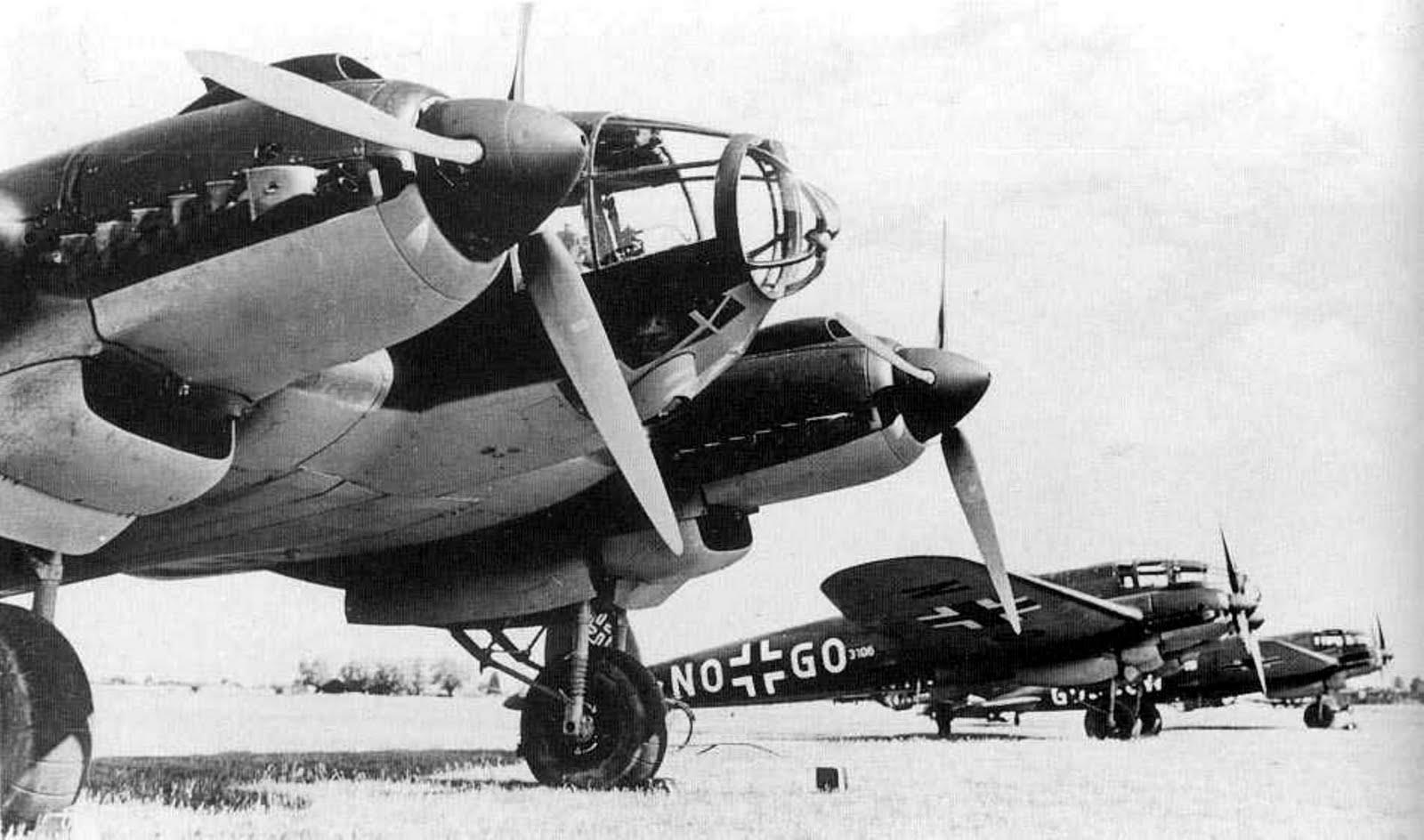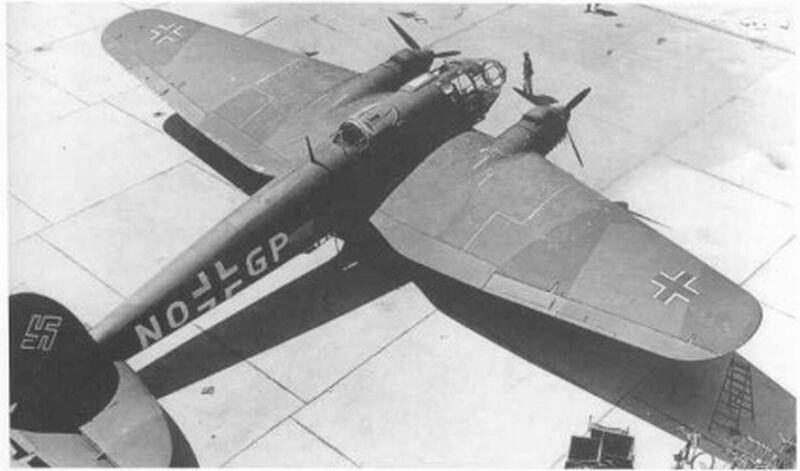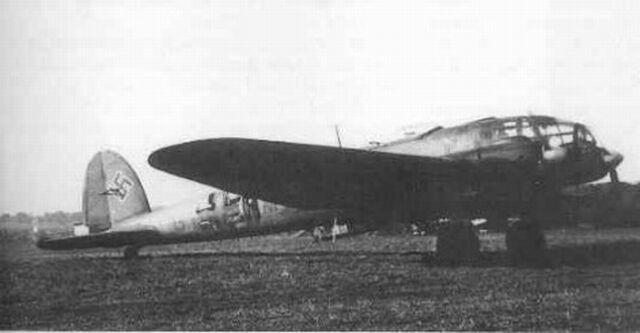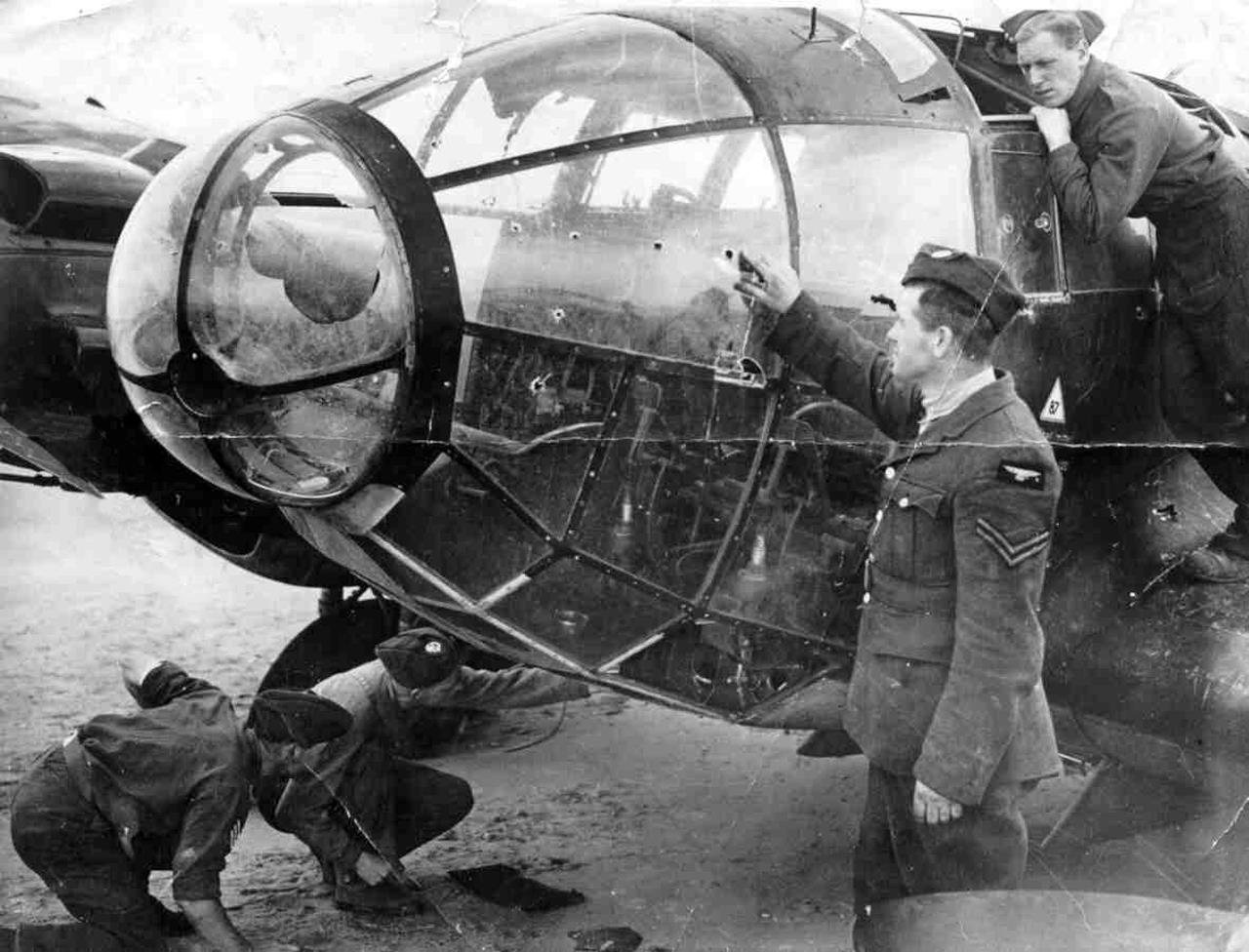| Type |
P-2 4-seat medium bomber |
P-4 5-seat medium bomber |
| Engine |
1 Daimler-Benz DB 601A |
| Dimensions |
Length 16,40 m , height 4,00 m , span 22,60 m , wing area 87,60 m2 , |
| Weights |
Empty 6020 kg, loaded 12570 kg , max. take off weight |
Empty 6775 kg, loaded 13500 kg, max. take off weight |
| Performance |
Max.. speed 390 km/h, cruising speed 310 km/h , range 2100 km, endurance , service ceiling 4300/7800 m , climb |
Max.. speed , cruising speed , range , endurance , service ceiling , climb |
| Armament |
4-5 7,92 mm MG 15 , bombload 1500 kg |
6 7,92 mm MG 15 , 1 7,92 mm MG 17, bombload 1500 kg |





The He 111P incorporated the updated Daimler-Benz DB 601A-1 liquid-cooled engine and featured a newly designed nose section, including an asymmetric mounting for an MG 15 machine gun that replaced the 'stepped' cockpit with a roomier and more aerodynamic glazed stepless cockpit over the entire front of the aircraft. This smooth glazed nose was first tested on the He 111 V8 in January 1938. These improvements allowed the aircraft to reach 475 km/h at 5,000 m and a cruise speed of 370 km/h although a full bomb load reduced this figure to 300 km/h The design was implemented in 1937 because pilot reports indicated problems with visibility. The pilot's seat could actually be elevated, with the pilot's eyes above the level of the upper glazing, complete with a small pivoted windscreen panel, to get the pilot's head above the level of the top of the "glass tunnel" for a better forward view for takeoffs and landings. The rear-facing dorsal gun position, enclosed with a sliding, near-clear view canopy, and for the first time, the ventral Bodenlafette rear-facing gun position, immediately aft of the bomb bay, that replaced the draggy "dustbin" retractable emplacement became standard, having been first flown on the He 111 V23, bearing civil registration
One of Heinkel's rivals, Junkers, built 40 He 111Ps at Dessau. In October 1938, the Junkers Central Administration commented:
Apparent are the externally poor, less carefully designed components at various locations, especially at the junction between the empennage and the rear fuselage. All parts have an impression of being very weak.... The visible flexing in the wing must also be very high. The left and right powerplants are interchangeable. Each motor has an exhaust-gas heater on one side, but it is not connected to the fuselage since it is probable that ... the warm air in the fuselage is not free of carbon monoxide (CO). The fuselage is not subdivided into individual segments, but is attached over its entire length, after completion, to the wing centre section. Outboard of the powerplants, the wings are attached by universal joints. The latter can in no way be satisfactory and have been the cause of several failures.
The new design was powered by the DB 601 Ba engine with 1,175 PS The first production aircraft reached Luftwaffe units in Fall 1938. In May 1939, the P-1 and P-2 went into service with improved radio equipment. The P-1 variant was produced with two DB 601Aa powerplants of 1,150 hp (860 kW). It also introduced self-sealing fuel tanks. The P-1 featured a semi-retractable tail wheel to decrease drag.Armament consisted of an MG 15 in the nose, and a sliding hood for the fuselage's dorsal B-Stand position. Installation of upgraded FuG III radio communication devices were also made and a new ESAC-250/III vertical bomb magazine was added. The overall takeoff weight was now 13,300 kg
The P-2, like the later P-4, was given stronger armour and two MG 15 machine guns in "waist" mounts on either side of the fuselage and two external bomb racks. Radio communications consisted of FuG IIIaU radios and the DB601 A-1 replaced the 601Aa powerplants. The Lotfernrohr 7 bombsights, which became the standard bombsight for German bombers, were also fitted to the P-2. The P-2 was also given "field equipment sets" to upgrade the weak defensive armament to four or five MG 15 machine guns. The P-2 had its bomb capacity raised to 4 ESA-250/IX vertical magazines. The P-2 had an empty weight of 6,202 kg , a loaded weight which had increased to 12,570 kg and a maximum range of 2,100 km
The P-3 was powered with the same DB601A-1 engines. The aircraft was also designed to take off with a land catapult (KL-12). A towing hook was added to the fuselage under the cockpit for the cable. Just eight examples were produced, all without bomb equipment.
The P-4 contained many changes from the P-2 and P-3. The jettisonable loads were capable of considerable variation. Two external SC 1,800 kg (4,000 lb) bombs, two LMA air-dropped anti-shipping mines, one SC 1,800 kg plus four SC 250 kg ; or one SC 2,500 kg external bomb could be carried on an ETC Rüstsatz rack. Depending on the load variation, an 835 L fuel and 120 L oil tank could be added in place of the internal bomb bay. The armament consisted of three defensive MG 15 machine guns. later supplemented by a further three MG 15s and one MG 17 machine gun. The radio communications were standard FuG X, Peil G V direction finding and FuBI radio devices. Due to the increase in defensive firepower, the crew numbers increased from four to five. The empty weight of the P-4 increased to 6,775 kg , and the full takeoff weight increased to 13,500 kg
The P-5 was powered by the DB601A. The variant was mostly used as a trainer and at least twenty-four production variants were produced before production ceased. The P-5 was also fitted with meteorological equipment, and was used in Luftwaffe weather units.
Many of the He 111 Ps served during the Polish Campaign. With the Junkers Ju 88 experiencing technical difficulties, the He 111 and the Do 17 formed the backbone of the Kampfwaffe. On 1 September 1939, Luftwaffe records indicate the Heinkel strength at 705
The P-6 variant was the last production model of the He 111 P series. In 1940, the Ministry of Aviation abandoned further production of the P series in favour of the H versions, mostly because the P-series' Daimler-Benz engines were needed for Messerschmitt Bf 109 and Bf 110 fighter production. The remaining P-6s were redesignated P-6/R2s and used as heavy glider tugs.[47] The most notable difference with previous variants was the upgraded DB 601N powerplants.
The P-7 variant's history is unclear. The P-8 was said to have been similar to the H-5 fitted with dual controls. The P-9 was produced as an export variant for the Hungarian Air Force. Due to the lack of DB 601E engines, the series was terminated in summer 1940.
| Type |
History |
| P-0 |
Pre serie Autumn 1938 |
| P-1 |
Spring 1939 |
| P-2 |
Summer 1939. FuG 10 instead of FuG 3 |
| P-3 |
Trainer with dual control. Autumn 1939 |
| P-4 |
Increased armour. 2 extra MG 15 |
| P-6 |
DB 601N, Delivered until summer 1940 |




